Sports
Track & Field Heads to AE Outdoor Championships
Story Links VESTAL, N.Y. – The Binghamton track & field teams travel to the America East Outdoor Track & Field Championships, which will be hosted by New Hampshire and run Saturday-Sunday. All nine conference programs will be competing in the meet. The Bearcats have four defending individual champions competing this […]
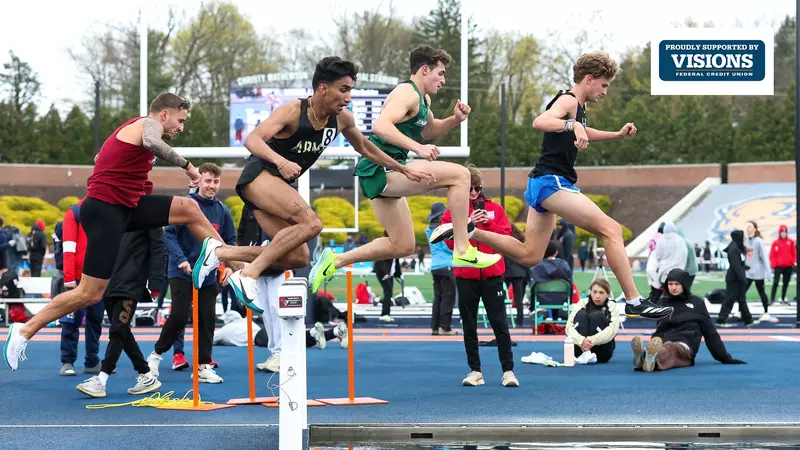
VESTAL, N.Y. – The Binghamton track & field teams travel to the America East Outdoor Track & Field Championships, which will be hosted by New Hampshire and run Saturday-Sunday. All nine conference programs will be competing in the meet.
The Bearcats have four defending individual champions competing this weekend. They include graduate student Marcus Johnson (400 hurdles), fellow graduate student Josh Stone (5,000) and sophomore Matthew Oluwole (high jump) on the men’s side as well as senior Jennifer Mui (3,000 SC) on the women’s squad.
Johnson and redshirt sophomore Brian Luciano are already locked in to the NCAA East Region Meet, which takes place later in the month. Lucinao is ranked No. 19 in the hammer (213-5) while Johnson is No. 18 in the men’s 400 hurdles (50.82). Both of them have been named America East Performers of the Week twice this season.
In addition, five Bearcats competing this weekend won individual events at the America East Indoor Championships back in February. They include Johnson (triple jump), Stone (5,000), Luciano (weight throw) and senior Joe Cardascia (500) on the men’s side as well as junior Alyssa Armitage (pole vault) on the women’s side.
At last year’s America East Outdoor Championships, the Bearcat women were the runner up for the second year in the row while the men took sixth place. During the recent indoor season, Binghamton was third on the women’s side while the men finished in fifth place.
Sports
How an oddball smuggled out the KGB’s biggest secrets
In March 1992 a scruffily dressed, unshaven old man knocked on the door of the newly opened British embassy in Vilnius, Lithuania. He was carrying what might have been a bag of laundry. From it he produced some pieces of paper on which were scribbled handwritten notes. The man said he wanted to speak to […]
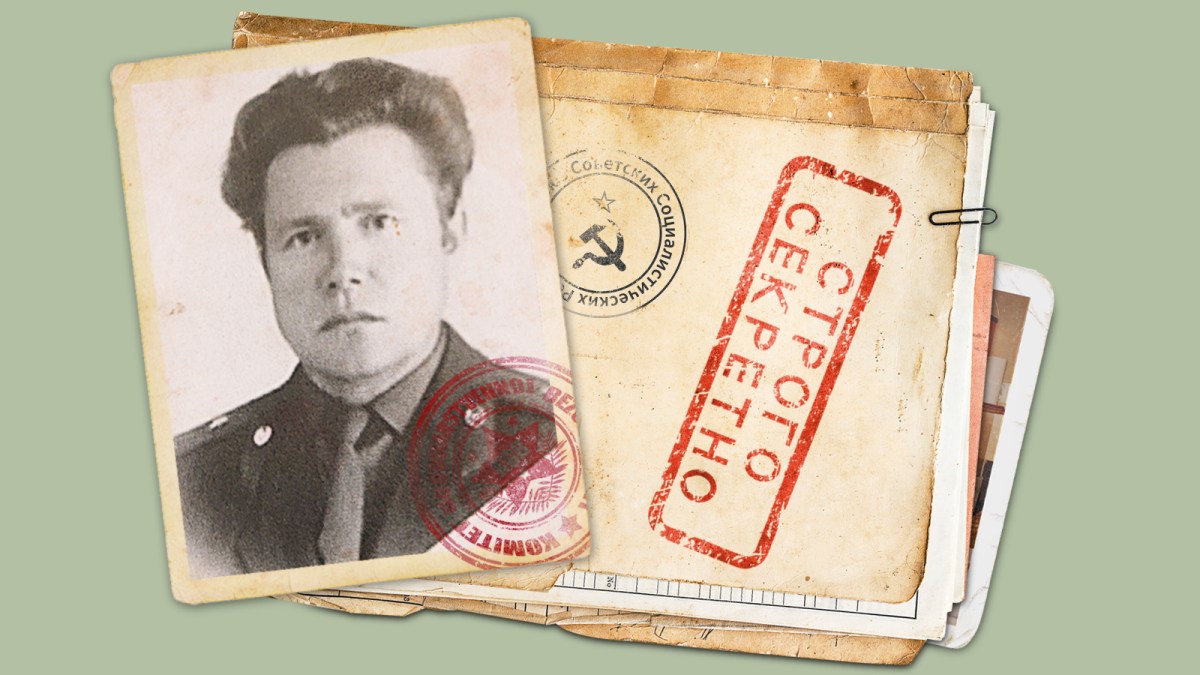
In March 1992 a scruffily dressed, unshaven old man knocked on the door of the newly opened British embassy in Vilnius, Lithuania. He was carrying what might have been a bag of laundry. From it he produced some pieces of paper on which were scribbled handwritten notes.
The man said he wanted to speak to somebody. Already the Americans had taken one look at him and sent him back into the cold. Luckily a junior female British diplomat had better instincts, for what Vasili Mitrokhin was touting was what the CIA would call “the biggest counterintelligence bonanza of the postwar period”.
His duffle bag contained many of the most important secrets in the KGB’s archive, where he had worked for three decades. The surreptitiously copied documents Mitrokhin would ultimately pass on to MI6 offered, its chief, Sir Richard Dearlove, said, “a sweeping overview of KGB operations over 50 years”.
Among the treasure dropped into the West’s lap were lists of names of numerous KGB agents abroad, both “illegals” — long-term penetration spies operating under false identities — as well as contacts passing on information. Shockingly, there proved to be 300 of the latter in the French establishment, and 30 in the Italian foreign ministry alone. In Britain Mitrokhin’s revelations led to the public unmasking of the last of the atom programme spies, Melita Norwood, dubbed by The Times, because of her shopping habits, “The spy who came in from the Co-op”.
Significant though this haul was, as tales of espionage go, one largely set amid the piled-up files of a vast bureaucracy is not an obvious page-turner. Moreover, the introverted Mitrokhin never offered much insight into the motivation for his actions and many of the details of his defection remain secret. Nevertheless, this is a wilderness that Gordon Corera, formerly the BBC’s security correspondent and now co-presenter with the spy novelist David McCloskey of the intelligence podcast The Rest Is Classified, is well equipped to traverse.
Whatever one makes of Mitrokhin — and his MI6 handlers thought him a prickly oddball — it certainly took remarkable courage to do what he did. Years of reading the files he was storing turned Mitrokhin from a true believer in communism into a quietly ardent opponent of its repressive machinery. When the KGB began moving its headquarters from the Lubyanka in Moscow to a new site in the 1970s — a huge operation as the organisation was generating three million documents a year — Mitrokhin was tasked with selecting which files should go and which should stay.
Some inconvenient ones had already been destroyed, for instance files that may have revealed the young Stalin was in touch with the tsar’s secret police. Determined to expose the system to the light, Mitrokhin started to make aides-memoire of what he read — tiny scraps of paper in code that he smuggled out of the archive hidden in his socks.
The KGB informant Melita Norwood was dubbed ‘The spy who came in from the Co-op’
TONY HARRIS/PA
Aided by a photographic memory, even for passport numbers and addresses, at weekends he would go to his country cottage, or dacha, and reconstitute the documents with a typewriter. This he christened Erika, and he thought of it as “the love of his life”.
• Meet ‘the illegals’ — Russia’s spies next door
All too aware of the resources and paranoia of the KGB, he took pains not to be seen to be buying equipment for Erika, instead making ink from fruit juice and fabricating new ribbons from scraps of old ones. For 12 years, until his retirement in 1984, Mitrokhin typed, burying what became the volumes he had compiled — one exposed the hidden scale of the Soviet Union’s losses in Afghanistan — in milk churns concealed under the dacha.
Had he been caught, the best he could have expected was a bullet in the back of the head. Given the necessarily slow pace of Mitrokhin’s work, however, Corera sensibly tries to broaden the story by setting it within the wider context of the Soviet Union’s history. That in turn offers some insights into Mitrokhin’s motivation.
• How Russia used Brazil as breeding ground for spies
“Defectors defect because they are defective,” runs an old spying trope. In Mitrokhin’s case he seems to have become disillusioned after being reprimanded when a field operative in Israel. Then, in 1956, while in Melbourne keeping an eye on the Soviet Union’s Olympic team, he found himself less than covertly in the sights of the press. He was photographed publicly urging the water polo team to hit back at their Hungarian opponents, who had vented their fury at the crushing of the uprising in Budapest then taking place.
A picture of a Hungarian player with blood running down his face went around the world, and the embarrassment led to Mitrokhin being sent to KGB’s equivalent of the salt mines: its archive.
The bloodied Hungarian water polo player Ervin Zador at the 1956 Olympics
BETTMANN ARCHIVE
What Corera conveys particularly well is Mitrokhin’s peculiarly Russian mindset. Mitrokhin could loathe the unfairness that underpinned how the KGB operated while staying a Russian nationalist, convinced of its moral superiority over the West. He especially deplored the KGB’s targeting of intellectuals, the guardians of Russia’s culture. The KGB was always hottest on defectors of this kind. Mitrokhin saw files revealing plots to break Rudolf Nureyev’s legs when he went to America, while 18 officers were dispatched to the Philippines to ensure that a chess player beat a formerly Russian
opponent.
Mitrokhin’s chance came with the end of the Soviet Union in 1991, the seismic event that seemed to end the career of a young KGB officer, Vladimir Putin. Corera has unearthed new details of his exfiltration. This was much more complex than that of, say, the KGB defector Oleg Gordievsky, as Mitrokhin wanted to bring not just his archive but his whole family, including his aged mother-in-law, none of whom had been told what was happening.
The operation was authentically chaotic rather than executed with Bond-like panache. Emergency numbers didn’t work, minibuses had to be commandeered in the street, and the wheelchair of Mitrokhin’s son — who suffered from a neurological illness — was too wide for the gangplank of the ship on which the family were meant to escape. Yet so low-key had Mitrokhin been all his life that no one noticed he had gone.
“Mitrokhin is a really difficult person,” observed Christopher Andrew, the Cambridge don who worked with him on publishing the archive commercially in 1999. “But he is also a hero.”
The book’s author Gordon Corera co-hosts the intelligence podcast The Rest Is Classified
The weird thing was that no one knew quite how to handle the weapon the West had been given. The Treasury jibbed at the cost of resettling Mitrokhin’s family, the politicians regarded information about a seemingly vanquished enemy’s historic operations as old hat, while the spooks would sometimes rather not have been reminded of their failure to catch moles.
Mitrokhin’s hope had been that his exposure of the KGB’s crackdown on domestic dissent would lead to Nuremberg-style justice for Russia’s former leaders. The West, however, focused more on what he revealed about the Soviet Union’s penetration of its bureaucracies and economies.
• Read more book reviews and interviews — and see what’s top of the Sunday Times Bestsellers List
In the years before he died, in 2004 at the age of 81, Mitrokhin became disappointed with what he found in the West, and nostalgic for the somewhat idealised, Tolstoyan version of the deep Russia he had left behind. Corera perhaps labours the point that it is a mentality shared with Putin and his supporters, yet The Spy in the Archive is nevertheless the overdue and often striking memorial Mitrokhin merits.
The Spy in the Archive: How One Man Tried to Kill the KGB by Gordon Corera (William Collins £25 pp336). To order a copy go to timesbookshop.co.uk. Free UK standard P&P on orders over £25. Special discount available for Times+ members
Sports
No. 11 Women’s Track and Field advances six events to NCAA Outdoor Championships
Story Links COLLEGE STATION, Texas – No. 11 Texas Women’s Track and Field finished the last day of the NCAA West First Round and advanced six events to the NCAA Outdoor Championships. The women’s 4×100-meter relay showed off a new lineup with Carleta Bernard, Holly Okuku, Kenondra Davis and Ramiah Elliott and […]

COLLEGE STATION, Texas – No. 11 Texas Women’s Track and Field finished the last day of the NCAA West First Round and advanced six events to the NCAA Outdoor Championships.
The women’s 4×100-meter relay showed off a new lineup with Carleta Bernard, Holly Okuku, Kenondra Davis and Ramiah Elliott and recorded a season-best time of 42.85 to advance to Eugene.
Sophomore Akala Garrett advanced in both hurdle events for the first time in her career after recording a personal-best non-winded time of 12.98 in the 100-meter hurdles. She later set the E.B. Cushing Stadium record in the 400-meter hurdles with a time of 54.72, the sixth-fastest time in UT history. Garrett will be the first Longhorn to compete at the NCAA Championships in both hurdle events in the same season since Rasin McIntosh competed in both events in 2003 and 2004.
Freshman Mackenzie Collins also reached the NCAA’s in the 400m hurdles, earning the last spot with a time of 57.14. It marks the second-straight season the Longhorns have sent a freshman to the NCAA Championships in the event after Garrett went last season.
Texas later sent two through in the 200-meter dash. Kenondra Davis equaled her personal best with a time of 22.58, moving her up to No. 10 on the school’s all-time performer list. Okuku qualified for her first individual NCAA event by matching her personal best with a time of 22.85, the 10th-fastest time of the night.
Results
Akala Garrett – 1st – 400mH – 54.72 (qualified)
Bernard, Okuku, Davis, Elliott – 2nd – 4×100 – 42.85 (qualified)
Akala Garrett – 5th – 100mH – 12.98 (qualified)
Kenondra Davis – 6th – 200m – 22.58 (qualified)
Holly Okuku – 10th – 200m – 22.85 (qualified)
Mackenzie Collins – 12th – 400mH – 57.14 (qualified)
Chrystal Herpin – 13th – Discus – 53.89m
Collins, Elliott, Bernard, Koom-Dadzie – 4×400 – 3:35.12
Elizabeth Stockan – 24th – 1500m – 4:34.62
Elizabeth Pickett – 33rd – 5000m – 16:36.68
Sports
Mosley Wraps Up CSUN’s Stay at the NCAA West First Round
Story Links COLLEGE STATION, Texas—CSUN Track & Field’s Summer Mosley concluded her stay at the NCAA West First Round on Saturday at E.B. Cushing Stadium by competing in the discus. Mosley would register her longest throw on her third and final attempt, which went for 50.09m (164-4). That throw would place her […]
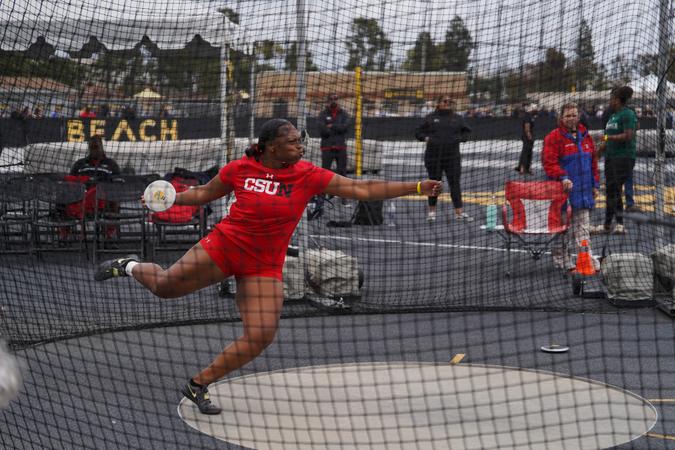
COLLEGE STATION, Texas—CSUN Track & Field’s Summer Mosley concluded her stay at the NCAA West First Round on Saturday at E.B. Cushing Stadium by competing in the discus.
Mosley would register her longest throw on her third and final attempt, which went for 50.09m (164-4). That throw would place her 38th overall out of a 48-athlete field, but short of advancing to the NCAA Outdoor Championships. Mosley also competed in the hammer throw this past Thursday at the regional, finishing 25th overall with a toss of 57.92m (190-0).
A native of Miami, Mosley had a career season in her first year with CSUN. Mosley would win two individual titles at the 2025 Big West Championships, finishing first in the hammer throw at 59.66m (195-9) and the discus at 53.51m (175-7). The two title wins were her first conference titles in her collegiate career.
Overall, CSUN was represented in nine different events at this year’s NCAA West First Round with six on the men’s team and three on the women’s team. The three regional appearances from the women were the most since the 2019 season. In all, CSUN broke three men’s records this outdoor season while 13 all-time top-10 marks were set across the men’s and women’s teams.
ACCORDING TO COACH JUSTIN JOHNSON
“I’m proud of our performances this week, even though things didn’t fall our way, I know that each student-athlete put their all into their performances. And for that, I am thankful and proud of each and every one of them. From the outside looking in, some may see this as a failure, but we are all on a journey seeking greatness and sometimes you will fall. There are great lessons to learned in defeat. I believe these young men and women have what it takes to pick each other up and continue on our journey in search of greatness. We will be back next year physically, mentally and emotionally stronger because of the experiences we have gone through and our willingness to do what it takes to be great. Go Matadors!”
#GoMatadors
Sports
Marquette University Athletics
COLLEGE STATION, Texas – Marquette University track & field student-athletes Danny Olsen and Annika Bynum competed in the NCAA West First Round this week. Olsen competed in the first round of the 400m on Wednesday night with a 46.48 second performance. Olsen had the 47th best time coming into the first round and finished 25th. […]
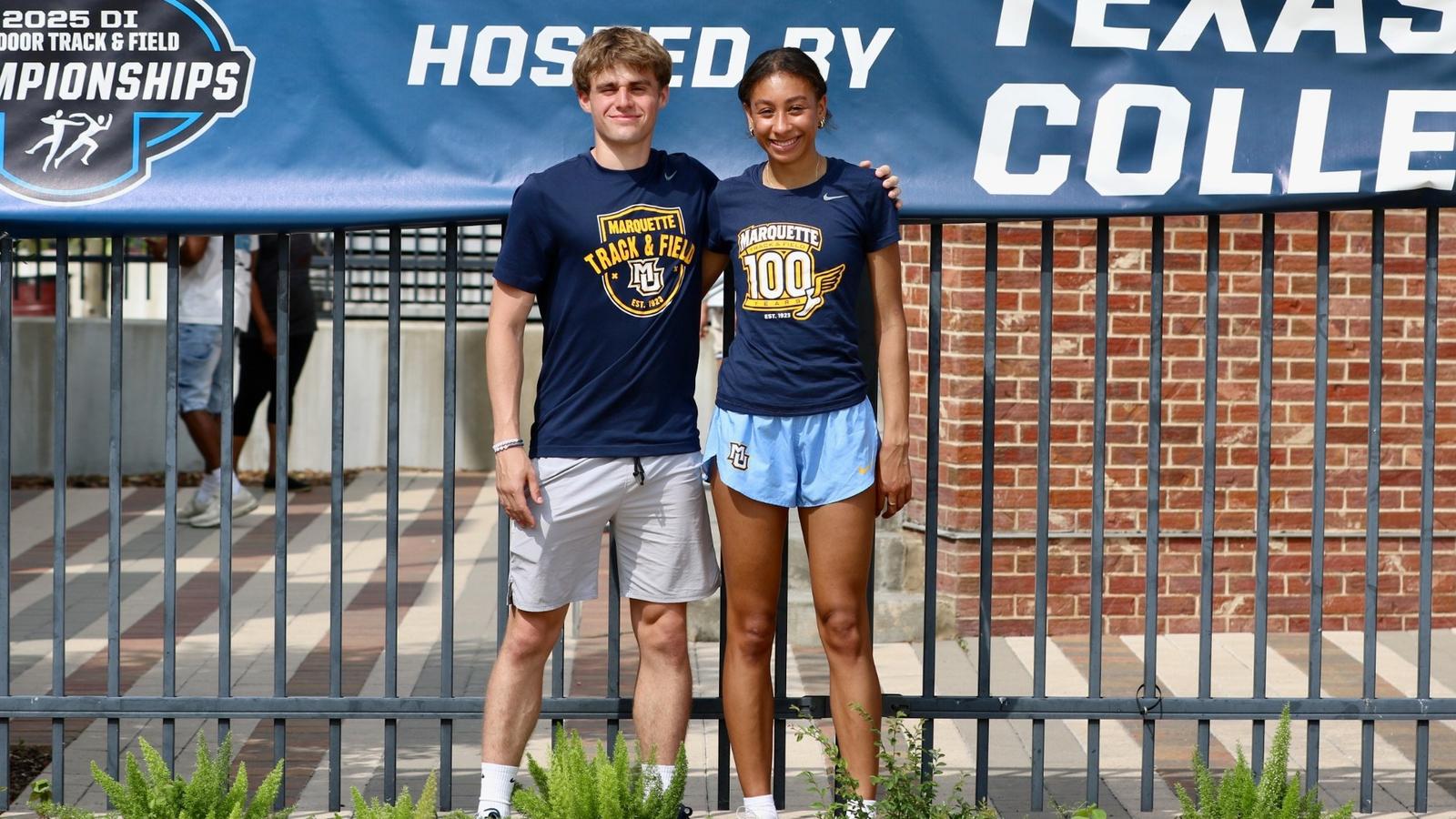
Olsen competed in the first round of the 400m on Wednesday night with a 46.48 second performance. Olsen had the 47th best time coming into the first round and finished 25th.
“It was a fantastic year for Danny,” Rogers said. “I’m super proud of his drive and perseverance this year. Our athletic trainer Matt Martin deserves a huge shout out. He did a great job with Danny working through a couple tough injuries this season. We are all excited for what the future holds.”
Olsen qualified for the NCAA first round after he won gold and broke his own program record with a time of 46.21 seconds in the 400-meter at the BIG EAST Outdoor Championships on May 17, becoming Marquette’s first ever conference champion in the event.
Bynum competed in the semifinals of the high jump for the second year in a row and no heighted on Saturday.
“It was a terrific season for Annika,” Rogers said. “Unfortunately, today wasn’t her day. She has been a tremendous leader on our team and made quite an impact on the program these past four years.”
Bynum qualified for the semifinals after tying the program record in the high jump, clearing 1.80 meters at the Uncaged Eagle Open on May 9.
Keep up with the Marquette men’s and women’s track and field programs through social media by following on X (@MUTFXC) and Instagram (@MUTFXC) and ‘liking’ on Facebook (/MUTFXC).
Sports
Tulane Finishes 15th at ICSA Open Fleet Race National Championship
ST. MARY’S CITY, Md. – With the regatta limited to one day of racing and only seven rotations Tulane University landed 15th out of 18 teams in the ICSA Open Fleet Race National Championship on Friday in St. Mary’s City, Maryland. The Green Wave ended the championship regatta with 161 total points through 14 […]
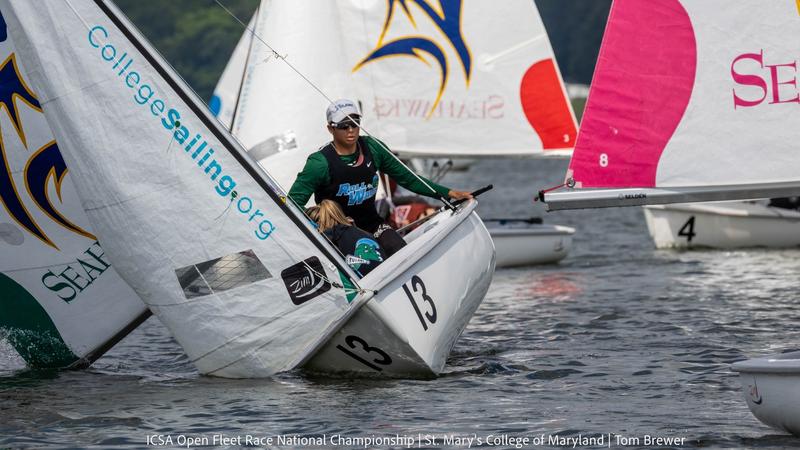
The Green Wave ended the championship regatta with 161 total points through 14 total races across two divisions.
Skippers Christian Ebbin and Hamilton Barclay teamed with crews Sabrina Anderson and CJ Ricci to pace the Wave on the water from the B Division. The Tulane quartet finished 10th in their division with 69 total points in seven races. Ebbin and Anderson paired together for three races and posted their best performance in the final rotation finishing fifth. Barclay and Ricci hit the water for four races together including a sixth-place performance in the duo’s best race.
In the A Division, skipper Kelly Holthus teamed with crew Taylor Bartell to finish 16th in the division. The Green Wave duo ended with 92 points across seven races on the waters of the St. Mary’s River. Holthus and Bartell combined for the best finish of the regatta for Tulane landing in fourth in their third race.
DOWNLOAD THE OFFICIAL TULANE ATHLETICS APP
Download the official mobile app of Tulane Athletics. Now, you can stay in touch with the Green Wave anytime and anywhere on your Android or iOS mobile device.
FOLLOW ON SOCIAL MEDIA
Follow Tulane Sailing on Twitter and Facebook and Instagram. Follow Tulane Athletics on Twitter, Facebook, and Instagram.
WE ARE NOLA BUILT
Tulane University is located in the city of New Orleans. It is a city built on tradition and resiliency. The lessons Green Wave student-athletes have learned through their connection with this university and city have BUILT doctors, lawyers, business leaders, conference champions, all-conference players, All-Americans, professional athletes and NCAA tournament teams. The city of New Orleans has shaped us into who we are today. We are One City. We are Tulane. We are NOLA BUILT. Check out our story at NolaBuilt.com.
Sports
Track and Field Wrap up Outdoor Season in NCAA First Round
Story Links COLLEGE STATION, Texas – The Central Arkansas track and field teams spend four days competing down at Texas A&M’s campus in the first round of the NCAA Championship. And though none of the Bears’ athletes advanced to Eugene, those that competed continued to add to the rising stock of […]
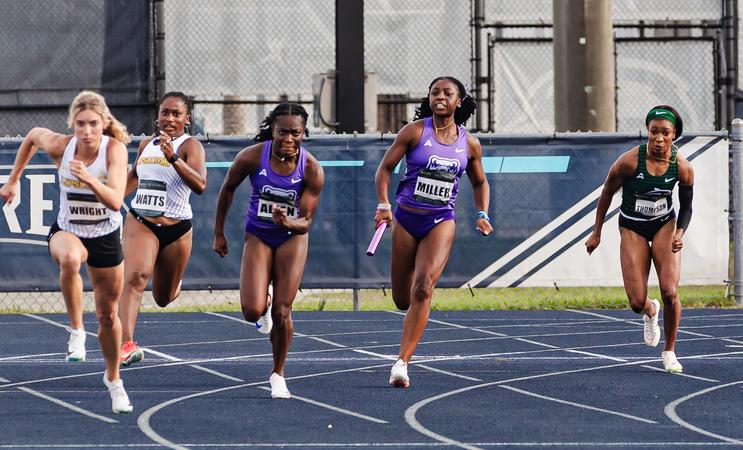
COLLEGE STATION, Texas – The Central Arkansas track and field teams spend four days competing down at Texas A&M’s campus in the first round of the NCAA Championship. And though none of the Bears’ athletes advanced to Eugene, those that competed continued to add to the rising stock of the track program at Central Arkansas.
“I’d be lying if we didn’t leave College Station wanting more this week. That being said, we had some great performances and competed well across the board,” Head coach Josey Weaver said of his team. “The experience we gained this week will be a building block for what’s to come.”
The men’s throwers started the week on Wednesday with the hammer toss, and Jaden Schneeberger led the way with a 63.53m toss, just .05 meters from tying his personal-best. Treavor Green was a short ways away with a 61.60m throw, and Aiden Patton registered a 58.59m toss. Jeff King took on the javelin in the early afternoon on Wednesday, and as one of nine freshmen in the competition, gave it a good effort, finishing with a distance of 57.36m. Jeremiah Boudreaux ran his heat of the 400m hurdles on Wednesday as well, and placed third in his heat with a 50.68 to qualify for Friday’s final.
Thursday, the women got started. Joia Perry opened competition in the hammer throw, and after what appeared to be a clinching distance of 62.22m, was edged out at the end, finishing 14th out of 48 throwers. Raghan Allen was next, competing in the 100m dash. She set a school record with a blazing time of 11.38, but came up .05 seconds away from moving on to Saturday’s finals.
Friday’s action had Pete Johnson competing in the 3000m steeplechase. And in an event that saw the top-nine finishers break the facility record, the Bears’ senior ran an 8:57.59, two seconds faster than his time at the ASUN Championships, finishing in 25th place. Later on in the evening, Boudreaux had his quarterfinal run in the 400m hurdles, but clipped one during his heat, unfortunately becoming disqualified.
Saturday, the women’s 4×100 team of Troynelle Miller, Raghan Allen, Baleigh Cashion and Brenae Allen had their second-best time of the season, clocking in at 45.35, but couldn’t secure a spot in Eugene.
“This has been an amazing ride with a remarkable group. I am very thankful for all of those who have contributed to building our program to the top of the ASUN Conference,” Weaver added. “We realize that we will have a target on our backs next year, and I’m looking forward to watching how our team responds.”
-

 College Sports2 weeks ago
College Sports2 weeks agoPortal Update – Basketball and Gymnastics Take Hits
-

 Rec Sports2 weeks ago
Rec Sports2 weeks agoThe Program, a New Basketball Training Facility, Opening in Greenpoint This September
-

 College Sports2 weeks ago
College Sports2 weeks agoPortal Update – Basketball and Gymnastics Take Hits
-

 Youtube3 weeks ago
Youtube3 weeks agoFACE OF THE LEAGUE CONTROVERSY
Stephen A. responds to LeBron’s NBA coverage criticism | First Take
-

 Motorsports3 weeks ago
Motorsports3 weeks agoNASCAR Cup Series Point Standings After Kansas
-

 Youtube3 weeks ago
Youtube3 weeks agoKYRIE Irving can’t miss!
-

 Youtube3 weeks ago
Youtube3 weeks agoThe Caitlin Clark Impact
-

 Professional Sports1 week ago
Professional Sports1 week agoJon Jones answers UFC retirement speculation as fans accuse champion of 'holding the belt …
-

 Youtube3 weeks ago
Youtube3 weeks agoSGA Iso Moments That Will Make You Say WOW
| 2024-25 NBA Season
-

 Youtube3 weeks ago
Youtube3 weeks agoCanon’s reaction to the Warriors’ loss
(via @nbcsportsauthentic/TT)








































